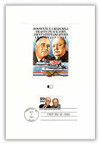
# 55907 FDC - 1991 WWII-Atlantic Charter 29c Proofcard
Often called the ultimate philatelic issue, the Fleetwood Proofcard is a distinctive commemorative with an elegantly embossed surface. Each Proofcard bears an original work of art complementing the theme of the stamp and created exclusively for Fleetwood by a leading American artist. Proofcards are often collected on their own, but would also make a beautiful addition to your existing stamp or cover collection.
Â
Atlantic Charter

On August 14, 1941, Franklin Roosevelt and Winston Churchill issued the Atlantic Charter, which defined the Allies’ postwar goals for the world.
In reality, the charter was a statement more than a legal document. It was the culmination of two years of communication between Roosevelt and Churchill.

The two leaders arranged to meet each other in secret in August 1941. At the time, President Roosevelt was on a 10-day fishing trip. On August 9, Churchill was aboard the HMS Prince of Wales when it steamed into Placentia Bay on the southeast coast of Newfoundland. There he met President Roosevelt who was on the USS Augusta.

This event marked the first time the two men would meet. After a brief silence, Churchill greeted Roosevelt, “At long last, Mr. President,†to which Roosevelt replied, “Glad to have you aboard, Mr. Churchill.â€Â After that, Churchill gave Roosevelt a letter from King George VI and delivered an official statement. Over the next few days, the two men discussed their goals for the war and postwar world.
On August 14, 1941, Roosevelt and Churchill presented their statement, then referred to as the Joint Declaration by the President and the Prime Minister. A few weeks later Churchill called it the Atlantic Charter and the name stuck.

The charter stated that the US supported the UK in the war and that both nations held the same hopes for a peaceful postwar world. A major focus was on the peace to come, rather than specific American involvement in the war itself. The charter consisted of eight main points: the US and UK didn’t seek any territorial gains; land that had been seized would be returned according to the wishes of the people; everyone would have a right to self-determination; trade barriers would be lowered; all nations would agree to economic cooperation and social welfare reform; all signers would work toward a world free from want and fear; there would be freedom of the seas; and aggressor nations would be disarmed.

There was no signed version of the document – it was developed over several drafts and then telegraphed to London and Washington. Shortly after its release, the Allied nations arranged a meeting in London on September 24 and unanimously agreed to adhere to the principles set forth in the charter.
Those that agreed on the charter then signed the Declarations by United Nations on January 1, 1942, which provided the basis for the modern United Nations. The Atlantic Charter is credited as the inspiration for several international agreements that followed.
Click here to read the text of the charter.
Â
Often called the ultimate philatelic issue, the Fleetwood Proofcard is a distinctive commemorative with an elegantly embossed surface. Each Proofcard bears an original work of art complementing the theme of the stamp and created exclusively for Fleetwood by a leading American artist. Proofcards are often collected on their own, but would also make a beautiful addition to your existing stamp or cover collection.
Â
Atlantic Charter

On August 14, 1941, Franklin Roosevelt and Winston Churchill issued the Atlantic Charter, which defined the Allies’ postwar goals for the world.
In reality, the charter was a statement more than a legal document. It was the culmination of two years of communication between Roosevelt and Churchill.

The two leaders arranged to meet each other in secret in August 1941. At the time, President Roosevelt was on a 10-day fishing trip. On August 9, Churchill was aboard the HMS Prince of Wales when it steamed into Placentia Bay on the southeast coast of Newfoundland. There he met President Roosevelt who was on the USS Augusta.

This event marked the first time the two men would meet. After a brief silence, Churchill greeted Roosevelt, “At long last, Mr. President,†to which Roosevelt replied, “Glad to have you aboard, Mr. Churchill.â€Â After that, Churchill gave Roosevelt a letter from King George VI and delivered an official statement. Over the next few days, the two men discussed their goals for the war and postwar world.
On August 14, 1941, Roosevelt and Churchill presented their statement, then referred to as the Joint Declaration by the President and the Prime Minister. A few weeks later Churchill called it the Atlantic Charter and the name stuck.

The charter stated that the US supported the UK in the war and that both nations held the same hopes for a peaceful postwar world. A major focus was on the peace to come, rather than specific American involvement in the war itself. The charter consisted of eight main points: the US and UK didn’t seek any territorial gains; land that had been seized would be returned according to the wishes of the people; everyone would have a right to self-determination; trade barriers would be lowered; all nations would agree to economic cooperation and social welfare reform; all signers would work toward a world free from want and fear; there would be freedom of the seas; and aggressor nations would be disarmed.

There was no signed version of the document – it was developed over several drafts and then telegraphed to London and Washington. Shortly after its release, the Allied nations arranged a meeting in London on September 24 and unanimously agreed to adhere to the principles set forth in the charter.
Those that agreed on the charter then signed the Declarations by United Nations on January 1, 1942, which provided the basis for the modern United Nations. The Atlantic Charter is credited as the inspiration for several international agreements that followed.
Click here to read the text of the charter.
Â













